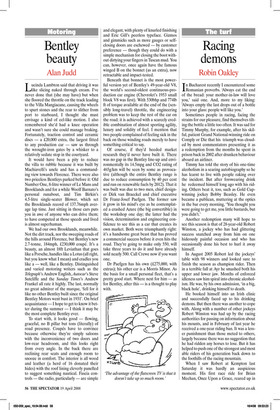Bentley beauty
Alan Judd
Lucinda Lambton said that driving it was like slicing naked through cream. I’ve never done that (she may have) but when she floored the throttle on the track leading to the Villa Mangiacane, causing the wheels to spurt stones and the rear to slither from port to starboard, I thought she must envisage a kind of eel-like motion. I also remembered she’d had a knee operation and wasn’t sure she could manage braking. Fortunately, traction control and ceramic discs — a £20,000 extra, the largest fitted to any production car — saw us through the wrought-iron gates by a whisker to a relatively sedate stop in the courtyard.
It would have been a pity to reduce the villa to rubble because it was built by Machiavelli’s uncle and has a commanding view towards Florence. There were also two priceless Bentleys parked before it: Old Number One, 8-litre winner of Le Mans and Brooklands and for a while Woolf Barnato’s personal runabout, and Tim Birkin’s 4.5-litre single-seater Blower, which set the Brooklands record of 137.76mph average lap time. Just sitting in those cars puts you in awe of anyone who can drive them; to have competed at those speeds and lived is almost superhuman.
We had our own Brooklands, meanwhile. Not the dirt track, nor the sweeping roads of the hills around Florence, but Bentley’s new 2.7-tonne, 184mph, £230,000 coupé. It’s a beauty, an almost 18ft Leviathan that goes like a Porsche, handles like a Lotus (all right, but you know what I mean) and cradles you like a — well, like a Bentley. Distinguished and varied motoring writers such as the Telegraph’s Andrew English, Autocar’s Steve Sutcliffe and the Sunday Times’s Andrew Frankel all rate it highly. The last, normally no great admirer of the marque, ‘fell for it like no other Bentley built since the original Bentley Motors went bust in 1931’. On brief acquaintance — I hope to get to know it better during the summer — I think it may be the most complete Bentley ever.
To start with, it looks good — flowing, graceful, no B pillar but tons (literally) of road presence. Coupés have to convince because otherwise they’re simply saloons with the inconvenience of two doors and low-rear headroom, and this looks right from every angle. In the back there are reclining rear seats and enough room to snooze in comfort. The interior is all wood and leather (a herd of 16 donated their hides) with the roof lining cleverly panelled to suggest something nautical. Fascia controls — the radio, particularly — are simple and elegant, with plenty of knurled finishing and Eric Gill’s peerless typeface. Gizmos and gimmicks such as more gauges or selfclosing doors are eschewed — by customer preference — though they could do with a simple mechanism for closing the boot without dirtying your fingers in Tuscan mud. You can, however, once again have the famous winged B on the bonnet (as an extra), now retractable and impact-tested.
Beneath that bonnet is the most powerful version yet of Bentley’s 49-year-old V8, the world’s second-oldest continuous-production car engine (Chevrolet’s 1953 small block V8 was first). With 530bhp and 774lb ft of torque available at the end of the (sensibly long-travel) throttle, the engineering problem was to keep the rest of the car on the road; it is achieved with a scarcely credible combination of almost sporting agility, luxury and solidity of feel. I mention that two people complained of feeling sick in the back on those winding roads merely to have something critical to say.
Of course, if they’d heeded market research they’d never have built it. There was no gap in the Bentley line-up and environmentally its 14.5mpg and CO2 rating of 465g/km will be seen by some as provocative (although the entire Bentley range is due to reduce consumption by 40 per cent and run on renewable fuels by 2012). That it was built was due to two men, chief designer Dirk van Braeckel and chief executive Dr Franz-Josef Paefgen. The former saw it grow in his mind’s eye as he contemplated a crashed Azure (the big convertible) in the workshop one day; the latter had the vision, determination and engineering confidence to see this as a car that creates its own market. Both were triumphantly right: it’s a handsome great beast that has proved a commercial success before it even hits the road. They’re going to make only 550, will take three years to do it and have already sold nearly 500. Call Crewe now if you want one.
Dr Paefgen has his own (£275,000, with extras); his other car is a Morris Minor. As the basis for a small personal fleet, that’s a pretty good start. Where next for him — as for Bentley, after this — is a thought to play with.


















































































 Previous page
Previous page